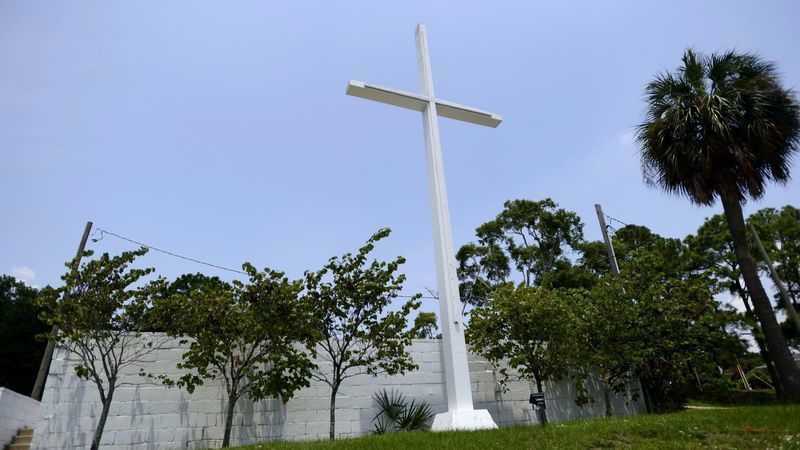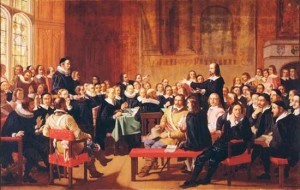
PENSACOLA, Fla. — A panel with the 11th Circuit Court of Appeals has upheld a ruling ordering the removal of a cross from a public park in Florida, stating that they were “bound by existing circuit precedent.” Two of the three judges said they were uncomfortable with the result and consequently called upon the the full circuit court to overturn their own ruling as precedent is “wrong” on the issue and the “Supreme Court’s Establishment Clause jurisprudence is a wreck.”
“Good law—stare decisis—sometimes leads good judges to follow bad law and write the wrong order. That happened in this case,” lamented Judge C. Ashley Royal.
He said that Christianity was woven into the very fabric of early America, and that modern society has difficulty understanding that aspect of history.
“The study of early American history teaches that Christianity was central to that history. Parenthetically then, a cross is not just a symbol of Christianity; it symbolizes America’s past—a past perhaps forgotten, neglected, ignored, or even despised, but nonetheless undeniable,” Royal explained.
“Without letting the founders speak, without hearing their words and reading their papers, I think it is hard for us living in our post-modern, highly secular society to understand the religiosity of early Americans and the often tyrannical adversity that beat down religious minorities like the Baptists and the Quakers,” he outlined.
“Yet, Alexis de Tocqueville understood and described this religiosity well. In his Democracy in America, written in the 1830s after he had spent several years traveling around the country, he said: ‘It was religion that gave birth to the Anglo-American Societies. This must always be borne in mind. Hence, religion in the United States is inextricably intertwined with all the national habits and all the feeling to which the fatherland gives rise.'”
Royal provided an extensive history of America’s beginnings, including the Puritans’ desire for a land where they could escape conformity to the Roman Catholic Church and worship God in the purity of the early Church.
He explained the controversies that arose as other denominations—such as Baptists, Quakers and Congregationalists—came into the picture, and it soon became apparent through disagreement over doctrine that men needed to call for “religious toleration” as there couldn’t be one particular national church. That is, the government wasn’t going to establish the Baptist, or Puritan, or Congregational denomination as being the official church of the nation. It couldn’t choose one over the other.
Men needed to be free to serve God according to the dictates of their consciences; they needed freedom of religion.
“Religious toleration, therefore, was for everyone, and the federal government could not establish a national church. This protected religious freedom in the new country. But state governments could be involved in religion, and ‘separation’ only operated at the national level,” Royal noted.
CASE BACKGROUND
As previously reported, the case surrounds a 25-foot cross erected in Bayview Park in Pensacola. The cross has been displayed in the public park for 70 years, and maintained by the City, without issue.
However, in 2016, the American Humanist Association (AHA) and the Freedom From Religion Foundation (FFRF) sued the City of Pensacola on behalf of four local residents who asserted that the cross violates the separation of church and state.
The groups had written to city officials to request that the display be removed, but their demands were rejected. Therefore, they took the matter to the courts.
“Mr. Kondrat’yev’s use and enjoyment of the local park is impeded by the Bayview Cross,” the legal complaint read, citing plaintiff Andreiy Kondrat’yev. “He feels a sense of peace and tranquility at the Bayview Park, but feels that is overshadowed by a religious symbol that signifies torture and violence to him.”
Kondrat’yev and his wife, who was also a plaintiff in the case, have since moved to Canada since becoming involved in the suit.
David Suhor, an atheist who delivered an invocation to Satan at the Pensacola city hall in 2016, was additionally one of the complainants in the legal challenge.
“Mr. Suhor objects to the government’s display of the Christian cross because he believes it is an endorsement of Christianity, placed primarily for religious purposes, including aggrandizing Easter Sunday services,” the filing read. “As a non-Christian, Mr. Suhor is personally offended and feels excluded by this governmental message. He opposes this appearance of governmental favoritism for religion and for a particular religion, Christianity.”
However, attorneys for the city argued in court that the cross is simply a longstanding part of Pensacola’s history and has never been construed as favoring one religion over another.
“To say that this cross is purely a religious symbol is wrong. It’s a Christian symbol, sure, but it’s used to honor those who have fallen on Veterans Day and Memorial Day,” Nixon Daniel of the law firm Beggs & Lane said. “So, from the city’s perspective, there is a secular purpose for it.”
“The city of Pensacola cannot go out today and put a cross there,” he also stated. “But the determining factor that you have to look at is this has been there for 40 years and no one has objected to it.”
In June 2017, U.S. District Court Judge Roger Vinson ruled that the cross must come down, although reluctantly. He outlined that he believes there is a difference between the original intent of the Founding Fathers regarding the Establishment Clause and the various case law that he felt bound to follow. He said that the cross would be deemed legal if viewed through the lens of what the nation’s founders intended.
“[H]ow is the Bayview Cross supposed to be analyzed? By applying [the] Lemon [standard]; one of the other tests; or no formal test at all?” he wrote. “May I look to what the Founding Fathers intended (in which case the cross is certainly constitutional), or must I look to how the ‘wall of separation’ metaphor has been applied (in which case it is probably unconstitutional)?”
The Reagan-appointed judge ultimately decided that he had to look to the outcome of a similar case in Rabun County where a cross that was determined to be of a religious nature was found to be unconstitutional.
COURTS ‘DO NOT UNDERSTAND … THE PAST’

On Friday, a three-judge panel with 11th Circuit Court of Appeals upheld Vinson’s ruling, and two of three declared, like Vinson, that the intention of the Founding Fathers was much different than what legal precedent asserts. They lamented that they were bound to follow that precedent, and called for their own ruling to be overturned by an en banc court.
Judge Kevin Newsom particularly pointed to the Rabun ruling as being bad case law.
“Whereas the Rabun Court thereby effectively dismissed history as a reliable guide for Establishment Clause cases, the Supreme Court has since made clear that history plays a crucial—and in some cases decisive—role in Establishment Clause analysis,” he said.
“How and to what extent, then, do ‘historical practices and understandings’ bear on this case? Pretty clearly and strongly, it seems to me. There is, put simply, lots of history underlying the practice of placing and maintaining crosses on public land—that practice, … comfortably ‘fits within the tradition long followed’ in this country,” Newsom outlined.
“Rabun was wrong the day it was decided … And to make matters worse, Rabun has only gotten more wrong as time has passed.”
But he also, like Vinson, expressed frustration with the inconsistent standards used by the U.S. Supreme Court in analyzing Establishment Clause cases.
“So, in the light of the Supreme Court’s most recent decisions, how exactly, should the Bayview Park cross’s constitutionality be determined? What Establishment Clause analysis applies? Frankly, it’s hard to say,” Newsom said. “The Court’s Establishment Clause jurisprudence is, to use a technical legal term of art, a hot mess.”
“Lemon came and went, and then came again—and now seems, perhaps, to have gone again. The Court flirted with an ‘endorsement’ standard for a while, but it too appears to have fallen out of favor. The ‘coercion’ test may still be a going concern, although it’s not quite clear when it applies, and there seem to be competing versions of it, in any event,” he noted.
Judge Royal concurred with Judge Newsom that the Establishment Clause, in not being viewed in light of the context of early American history, has been mangled by the courts, leaving judges confused on the issue and unsure of which standard to utilize.
“I agree with Judge Newsom that the Establishment Clause jurisprudence is a ‘hot mess,’ but I think of it more like a wilderness with misdirecting sign posts and tortuous paths. The bad signposts and twisted paths are the various Establishment Clause tests: separation, accommodation, history, neutrality, Lemon, endorsement, and coercion, all used at one time or another, in one case and then not in another,” he outlined.
“Next is the bog of concurring and dissenting opinions, and the opinions that concur in the judgment only, that leave you with the sense that you are walking on unsettled earth,” Royal declared. “Moreover, it is difficult to get out of a wilderness when all you look at is what is immediately in front of you and do not understand the patterns and directions of the past.”
Become a Christian News Network Supporter...


